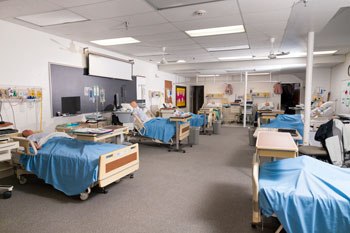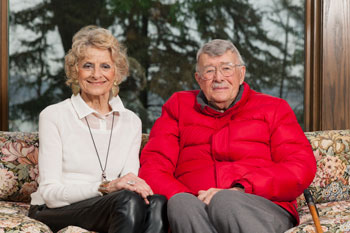CSB embarks on nursing department renovation
January 16, 2015


Barbara and Guy Schoenecker
In medical terms, the nursing facility at the College of Saint Benedict was close to flatlining. Built in 1973, the area on the fourth floor of the Main Building was designed long before sweeping changes came to the medical field, in terms of both pedagogy and technology.
But building on the tradition of excellence and leadership CSB has established in nursing that facility will be changing for the 21st century. This spring, the college will begin renovating and expanding the nursing facility.
The $2.5 million renovation is made possible, in part, through a $700,000 gift by Guy and Barbara Schoenecker; a $500,000 grant from the Margaret A. Cargill Foundation; and other donations. The Schoeneckers gave an additional $500,000 to endow the nursing program, to accompany CSB alumna Sharon Ridgeway's '81 previous commitment of $500,000; both gifts will ensure the program's long-term sustainability.
The renovated facility will be known as the Schoenecker Nursing Education Center, in recognition of their generous lead gift.
"The donations and grant recognize the transformational potential of this renovation project and the college's role in providing high quality health care in the region," said Mary Dana Hinton, president of CSB. "The renovation will not only transform the physical space in which we teach nursing at the College of Saint Benedict and Saint John's University, but also enhance the quality of instruction we are able to provide our nursing students."
The goal is to help future nurses meet current and emerging health care demands by creating a realistic work environment. It is expected to be completed by the start of fall semester, 2015, with the department being temporarily housed in Richarda Hall while the renovations take place.
"This renovation finally allows us to create a simulated learning space that is up-to-date," explained Carie Braun, professor of nursing and chair of the department. The redesigned area will include:• Six simulation rooms, which are small, flexible spaces that will look like actual patient care settings. (The old setting resembled more of a hospital ward.) The rooms will be equipped with ceiling-mounted cameras and microphones, so students can record and analyze their experiences.
- A simulation control center where faculty members can control the blood pressure and heart rate of the manikins, vocalizations of the manikins and monitors in the room. Faculty members will also be able to observe multiple simulations going on at the same time.
- Two interactive classrooms, where faculty members can circulate throughout the room observing high-impact problem solving activities such as a patient and family scenario.
- A large contextual-learning/practice laboratory where students can move between group problem solving and hands-on psychomotor skill practice. It will be an ideal space for faculty to observe multiple students during practice simulations.
- A fully functional nurses' station — the hub of any hospital unit. Students will prepare for entering the simulation rooms to provide care. At this station, students and faculty can create a setting for interdisciplinary collaboration. • A seminar space for small group meetings (up to 18 students) to conduct business, discussions and presentations.
The nursing major, which began in 1971, serves 162 CSB and SJU students a year (54 seniors, 54 juniors, 54 sophomores) and employs 17 full-time faculty. Over 2,000 alumnae/i serve in the health industry around the world. The National Council Licensure Examination passage rates for CSB and SJU students consistently exceed the national average.
Individually, nursing is the fourth-largest major at CSB; one in five CSB students come to the college seeking nursing as a major. "We continue to educate nurses within a liberal arts environment and in the Benedictine tradition of serving the needs of our community," Hinton said.
